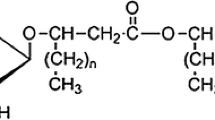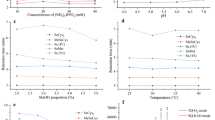Abstract
This report describes the extraction of selenium species contained in pharmaceutical tablets using either enzymatic hydrolysis or sodium dodecyl sulphate extraction (SDS). The selenium species were determined by ion chromatography coupled to inductively coupled plasma mass spectrometry. In the enzymatic extraction approach, proteolytic enzymes (protease/lipase) were used in a buffer containing 75 mM Tris–HCl at pH 7.5. It was found that the extraction efficiency was significantly improved relative to the use of the SDS approach. For example, the extraction recovery was more than 80% of total Se, where selenocystine Se-methyl-selenocysteine (SeMC) and selenomethionine (SeMet) in the samples were extracted. In contrast, chemical extraction of Se using SDS gave only 60% of total Se, while only two species, SeMC and SeMet, were found. In addition, SeMC was found to be unstable and degraded through oxidation in the extraction solution. Finally, the two enzyme methods were applied to commercial pharmaceutical tablets.



Similar content being viewed by others
References
Tan JA, Zhu W, Wang W, Li R, Hou S, Wang D, Yang L (2002) Selenium in soil and endemic diseases in China. Sci Total Environ 284:227
Tinggi U (2003) Essentiality and toxicity of selenium and its status in Australia: a review. Toxicol Lett 137:103
Wrobel K, Kannamkumarath SS, Caruso JA (2003) Hydrolysis of proteins with methanesulfonic acid for improved HPLC-ICP-MS determination of seleno-methionine in yeast and nuts. Anal Bioanal Chem 375:133
B’Hymer C, Caruso JA (2006) Selenium speciation analysis using inductively coupled plasma-mass spectrometry. J Chromatogr A 1114:1
Weixiao W, Jingyin L, Huimin D, Jing H, Shufang L (2006) Determination of selenium in biological materials using an ion-selective electrode. Microchim Acta 154:143
Ajtony Z, Szoboszlai N, Bella Z, Bolla S, Szakál P, Bencs L (2005) Determination of total selenium content in cereals and bakery products by flow injection hydride generation graphite furnace atomic absorption spectrometry applying in-situ trapping on iridium-treated graphite platforms. Microchim Acta 150:1
Bidari A, Hemmatkhah P, Jafarvand S, Milani Hosseini MR, Assadi Y (online first) Selenium analysis in water samples by dispersive liquid–liquid microextraction based on piazselenol formation and GC-ECD, Microchim. Acta, doi:10.1007/s00604-008-0003-8
Yang L, Sturgeon RE, Wolf WR, Goldschmidt RJ, Mester Z (2004) Determination of selenomethionine in yeast using CNBr derivatization and ID GC-ICP-MS and GC-MS. J Anal At Spectrom 19:1448
McSheehy S, Yang L, Sturgeon RE, Mester Z (2005) Determination of methionine and selenomethionine in a candidate selenium-enriched yeast reference material using species specific id with liquid chromatography-MS and ICP-MS. Anal Chem 77:344
Mester Z, Willie SN, Caruso JA, Fernandez ML, Fodor P, Goldschmidt RJ, Infante HG, Lobinski R, Maxwell P, McSheehy S, Polatajko A, Sadi BM, Sanz-Medel A, Sturgeon RE, Szpunar J, Wahlen R, Wolf W, Yang L (2006) Certification of a new selenized yeast reference material for selenomethionine, methionine and selenium and its use in an intercomparison exercise for quantitation of these analytes. Anal Bioanal Chem 385:168
Goenaga-Infante H, Sturgeon R, Turner J, Hearn R, Sargent M, Maxwell P, Yang L, Barzev A, Pedrero Z, Camara C, Huerta VD, Sanchez MLF, Sanz-Medel A, Emese K, Fodor P, Wolf W, Goldschmidt R, Vacchina V, Szpunar J, Valiente L, Huertas R, Labarraque G, Davis C, Zeisler R, Turk G, Rizzio E, Mackay LG, Myors RB, Saxby DL, Askew S, Chao W, Jun W (2008) Total selenium and selenomethionine in pharmaceutical yeast tablets: assessment of the state of the art of measurement capabilities through international intercomparison study CCQM P86 H. Anal Bioanal Chem 390:629
Yang L, Mester Z, Sturgeon RE (2004) Determination of methionine and selenomethionine in yeast by species-specific isotope dilution GC/MS. Anal Chem 76:5149
Yang L, Sturgeon RE, McSheehy S, Mester Z (2004) Comparison of extraction methods for quantitation of methionine and selenomethionine in yeast by species specific isotope dilution gas chromatography–mass spectrometry. J Chromatogr A 1055:177
Casiot C, Szpunar J, Lobinski R, Potin-Gautier M (1999) Sample preparation and HPLC separation approaches to speciation analysis of selenium in yeast by ICP-MS. J Anal Atom Spectrom 14:645
Huerta VD, Sanchez MLF, Medel AS (2004) Quantitative selenium speciation in cod muscle by isotope dilution ICP-MS with a reaction cell: comparison of different reported extraction procedures. J Anal Atom Spectrom 19:644
Gayon JMM, Thomas C, Feldmann I, Jakubowski M (2000) Comparison of different nebulisers and chromatographic techniques for the speciation of selenium in nutritional commercial supplements by hexapole collision and reaction cell ICP-MS. J Anal Atom Spectrom 15:1093
Chassaigne H, Chery CC, Bordin G, Rodriquez AR (2002) Development of new analytical methods for selenium speciation in selenium-enriched yeast material. J Chromatogr A 976:409
B’Hymer C, Caruso JA (2001) Canadian soil quality guidelines selenium environmental and human health effects. Can J Anal Sci Spectrosc 46:136
B’Hymer C, Caruso JA (2000) Evaluation of yeast-based selenium food supplements using high-performance liquid chromatography and inductively coupled plasma mass spectrometry. J Anal Atom Spectrom 15:1531
Larsen EH, Sloth J, Hansen M, Moesgaard S (2003) Selenium speciation and isotope composition in 77Se-enriched yeast using gradient elution HPLC separation and ICP-dynamic reaction cell-MS. J Anal Atom Spectrom 18:310
Polatajko A, Sliwka-Kaszynska M, Dernovics M, Ruzik R, Encinar JR, Szpunar J (2004) A systematic approach to selenium speciation in selenized yeast. J Anal Atom Spectrom 19:114
Encinar JR, Schaumloffel D, Ogra Y, Lobinski R (2004) Determination of selenomethionine and selenocysteine in human serum using speciated isotope dilution-capillary HPLC-inductively coupled plasma collision cell mass spectrometry. Anal Chem 76:6635
Huerta VD, Reyes LH, Gayon JMM, Sanchez MLF, Medel AS (2003) Total determination and quantitative speciation analysis of selenium in yeast and wheat flour by isotope dilution analysis ICP-MS. J Anal Atom Spectrom 18:1243
Bermejo P, Capelo JL, Mota A, Madrid Y, Camara C (2004) Enzymatic digestion and ultrasonication: a powerful combination in analytical chemistry. Trends Anal Chem 23:654
Capelo JL, Embun PX, Albarran YM, Camara C (2004) Enzymatic probe sonication: enhancement of protease-catalyzed hydrolysis of selenium bound to proteins in yeast. Anal Chem 76:233
Dernovics M, Stefanka Z, Fodor P (2002) Improving selenium extraction by sequential enzymatic processes for Se-speciation of selenium-enriched Agaricus bisporus. Anal Bioanal Chem 372:473
Acknowledgment
WH Wang gratefully acknowledges a grant from Australia Postgraduate Awards (APA) and Cooperative Research Centre for Contamination Assessment and Remediation of Environments (CRC CARE), Australia.
Author information
Authors and Affiliations
Corresponding author
Rights and permissions
About this article
Cite this article
Wang, W., Chen, Z., Davey, D.E. et al. Extraction of selenium species in pharmaceutical tablets using enzymatic and chemical methods. Microchim Acta 165, 167–172 (2009). https://doi.org/10.1007/s00604-008-0115-1
Received:
Accepted:
Published:
Issue Date:
DOI: https://doi.org/10.1007/s00604-008-0115-1




